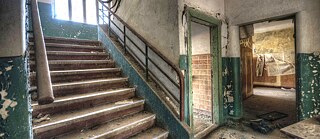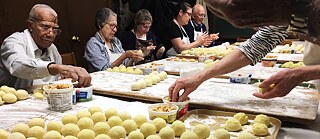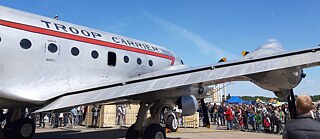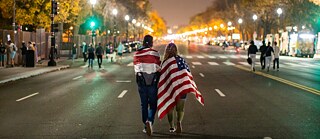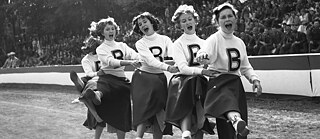Spurensuche in Frederick
Hessian Barracks in Maryland
30.000 deutsche Soldaten hessischer Herkunft sollen während des Amerikanischen Unabhängigkeitskrieges (1775–1783) auf Seiten der Briten gekämpft haben. Nach der Niederlage wurden die überlebenden Deutschen als Kriegsgefangene in Frederick, Maryland, unter merkwürdigen Umständen interniert.
Diese Folge anhören: Apple Music | Spotify | Download
Diese Folge stammt von Rob Sachs. Rob arbeitet seit 2000 für den US‑amerikanischen Hörfunk und produzierte NPR‑Sendeformate wie „All Things Considered“. Er war Produktionsleiter von „America Abroad“, einer Dokumentarreihe auf Public Radio International. Rob lebt mit seiner Frau und drei Kindern in Maryland. In diesem Podcast unterhält sich Rob mit Chad Baker von der hessischen Kaserne, einem Historiker, mit Kirchenmitgliedern und Bürger*innen von Frederick sowie mit dem Inhaber der deutschen Bierhalle Old Stein Inn in der Nähe der Chesapeake Bay. Die Musik der Folge stammt aus einem Konzert von Mike Surratt & The Continentals am 26. Januar 2019 im Old Stein Inn, mit freundlicher Genehmigung von Mike Surratt & The Continentals: „Celebrating 50 Years“ ist lizenziert als Public Domain Mark 1.0; „Yankee Doodle“ lizensiert als Public Domain und beide werden vorgetragen vom United States Army Old Guard Fife and Drum Corps. Das Foto zur Folge hat Rob Sachs aufgenommen, es zeigt die hessische Kaserne in Maryland. Außer dieser Episode hat Rob Sachs die Folge „U.S.-American Soccer and the World“ produziert.
Transkript
Rob Sachs: Drive northwest from Washington, D.C. for about an hour and you’ll hit Frederick, Maryland, a quaint city of about 70,000 residents. Today, there are hip new coffee houses and antique stores popping up along colonial streets. Up on the hill from the main drag is the Maryland School for the Deaf. Most of the buildings there were constructed in the 1950s and ’70s. But right in the middle, one building sticks out. It has a limestone exterior and it looks really, really old.
Chad Baker: The building was funded in 1777 by the Maryland General Assembly and was completed by 1781.
Rob Sachs: That’s Chad Baker.
Chad Baker: I am the person that’s responsible for taking care of the barracks, and for its recent renovations that were just completed last year.
Rob Sachs: Baker was also, one time, a principal at the School for the Deaf, and he started a historic museum on the school property.
Chad Baker: And right next to this museum are the Hessian Barracks.
Rob Sachs: So if you want to know any history about the place, he’s the person to talk to. As we stood outside the Hessian Barracks, it occurred to me that this looked nothing like a prison.
Chad Baker: The barracks were originally built to quarter U.S. military, not a prisoner-of-war camp. And what you see is the precursor to what I call the ‘Holiday Inn look.’ It’s a two-story building, and you’ll notice if there’s a window upstairs, there’s a window downstairs. If there’s a door upstairs, there’s a door downstairs. And that pattern repeats: Window, door, door, window, window, door, door, window, window, door, door — wherever you look.
Rob Sachs: Before we get more into the design and use of the Barracks, first a little history lesson: Think back to high school when you were studying the Revolutionary War — remember George Washington crossing the Delaware on Christmas night for that surprise attack in Trenton? He actually wasn’t attacking British soldiers, but rather a troop of Hessians as any Washington reenactor will tell you.
Reenactor: I have recently met with my council of war and we have decided we are crossing again, back into the Jerseys, and attacking the Hessian outpost in Trenton.
Rob Sachs: You often hear these Hessians are referred to as German mercenaries — soldiers paid by the British to fight Washington and his Continental Army. But their background is a bit more complex.
Chad Baker: At the time, the king of England is a Hanoverian King — which means he was not British. Literally. Spoke German fluently, and his family background is from Hesse, Germany — as in, Hessian soldiers — and they were actually paid by Germany, not by England, to come over and fight the war. So technically they really are not mercenaries. It was more like a family affair. They were doing this for the — for the Crown of England, because it was German.
Rob Sachs: And fight, they did. It was estimated that 30,000 Hessians fought for the British during the Revolutionary War. Though they were defeated in the Battle of Trenton in 1776, they fought other major battles, such as Saratoga and Yorktown. After these skirmishes, the Continental Army needed a place to house these captured soldiers. So they turned to these barracks in Frederick, Maryland.
Chad Baker: It got federalized, if you will. Instead of housing Maryland militia, it turned into a POW camp. The first occupants that were POWs were actually the British, after the Battle of Saratoga. And those were called Conventioneers. They are eventually moved out of here, and the Hessians that were part of that battle that were captured — they stayed here in Frederick but they stayed downtown. Then after the Battle of Yorktown, all the German prisoners were brought up to Frederick and combined with the ones that were downtown, and the British were then moved over to York, Pennsylvania, to be housed as prisoners there. So they all came here by design, as prisoners of war.
Rob Sachs: So what did the community of Frederick make of having hundreds of enemy soldiers being housed in their backyard? Well for the most part, they liked it.
Chad Baker: We need to keep in mind that Frederick, Maryland, at this time of the Revolutionary War, is German-speaking, by and large. You can go to the store, you can go to the bank, and everybody is conducting business in German. You go to the pharmacy, it’s in German. Religious services on Sunday — in German. So, when the Germans came here, they could go anywhere they wanted. They could go downtown, they could go shopping, they go work on the farm, as many did — and there was no language barrier. So they fit in quite nicely, and they brought a lot of money with them.
Rob Sachs: That’s right, these Hessians came with disposable incomes.
Chad Baker: Because the Germans were faithful to their soldiers. They paid them in gold and silver even though they were prisoners. And the U.S. government did not get in the way of that money coming into Frederick. And of course, then they spent in the local businesses. So it was an economic driver for sure. Fifteen- to seventeen-hundred prisoners all at once have gold and silver to spend.
Rob Sachs: If this seems implausible — that German prisoners of war were propping up the local economy while they were in detention — think back to those barracks. They were hardly what you’d call maximum security, or even minimum security really.
Chad Baker: The security when the British POWs were here was quite high. And in fact, there were a lot of clashes between the guards and the POWs. When they left, however, you would get kids 14, 15 years old. They were not embattled yet, and they were assigned to be the guards of the German soldiers. So, yes, you could come in and out and walk freely all over town. And sometimes you came back at night, sometimes you didn’t.
Rob Sachs: And that’s just because there was a lot more trust.
Chad Baker: Yes. Trust, and all kinds of liaisons are now happening during the time they were here.
Rob Sachs: And maybe almost antipathy, whereas with the British there was maybe more of a stark contrast.
Chad Baker: I would say that would be quite true. You have a German-speaking community from the same part of Germany that these prisoners are coming in. They may be a generation or two older, in terms of being in the United States, than these new Germans being brought in — but nonetheless, they still had the same fatherland.
Rob Sachs: As Chad and I walked through the old Barracks, I tried to imagine what it must have been like to have stayed there well over two centuries ago. It wasn’t that hard — the building was in really good shape.
Chad Baker: We have original glass, original stone, original mortar, original plaster, with horsehair still hanging out of it. So there’s about 80 percent original material in the building. And it’s the only military installation extant from that period.
Rob Sachs: In Maryland?
Chad Baker: In the United States.
Rob Sachs: In the whole United States? Wow.
We walked into a musky old room that was about the size of a bedroom. Up in the rafters, I could see large exposed wooden beams. The walls were sealed with white plaster.
Chad Baker: If you can imagine they had bunk beds that were three high and had three men on each level. So there were nine in one set of bunk beds, and nine in the other. So in this room — which is seven steps by eight steps — you had 18 men.
Rob Sachs: The only other thing of note in the room is a fireplace on the far wall. Chad showed me some other rooms. They all look identical.
Chad Baker: Again, you have a door, and a window, and a fireplace to keep warm by. When you go to the second floor, it is the same thing all over again. You have a fireplace, a door, and a window, and that’s it.
Rob Sachs: Pretty austere. But there were some other options. Some soldiers chose to sleep outside, even in the winter. Others had better deals.
Chad Baker: If you had enough money and your rank was high enough, your family came with you. So, there were at least eight German officers who lived in downtown Frederick with their wives and their children. And they also become part of the community here in Frederick.
Rob Sachs: The whole arrangement only lasted about a year and a half, though. The Battle of Yorktown, where many of those Hessians POWs came from, was in October of 1781 — and it marked the virtual end of the Revolutionary War. Two years later, at the Treaty of Paris, Benjamin Franklin, John Adams, and John Jay negotiated peace with Great Britain.
[FIFE MUSIC PLAYING]
[MALE VOICE: “THE REBELS HAVE ACHIEVED THE IMPOSSIBLE, THE UNITED STATES IS THE ONLY COUNTRY TO WIN INDEPENDENCE FROM BRITAIN IN WAR.”]
Rob Sachs: To learn more about what happened after that, I met up with local historian Tom Sherald.
Tom Sherald: I’m a member of the Sons of the American Revolution in Frederick County, and a member of a committee that is studying the impact of the German Hessian prisoners that were held here during the Revolutionary War.
Rob Sachs: Sitting in a library in Frederick, he pulled out a history of the period and read to me what happened next.
Tom Sherald: [READING] In March 1783, news of the end of hostilities received from Philadelphia. On the third day of the Easter holidays, there was a general celebration. Cannons firing all day, two city companies in Frederick in the militia parade, with white flags with 13 stripes for the 13 colonials. Our American guard was withdrawn, and we were left quite free. The American officers and gentlemen gave a great ball at 9 p.m. There were fireworks, which cannoneers made. The whole town was illuminated, and there was a great fire of small arms. The day of departure from Frederick, 12th of May 1783, greater numbers of the former prisoners of war — commonly known as Hessians — declared their preference to remain in America rather than returning home to Germany. Within seven years the immigration — which had begun as a military arrangement between British and German sovereigns — became an opportunity for their subjects to participate in democracy, which they had been paid to oppose. And the trickle of desertions in Western Maryland, which had begun slowly in 1778, became a wave of fresh immigration into Frederick County and the newly formed Washington County.
Rob Sachs: As for the Hessian Barracks, they would go on to serve many other functions: a school, a museum, a place for storage. This all got me thinking. So, if the Hessians were only here for a year and a half, why is it named the Hessian Barracks? Seems like it could have been called anything.
Tom Sherald: When you talk with people from Frederick, who have been born and raised here, they always refer to it as the Hessian Barracks. When I speak to groups, I usually refer to it as the Frederick Town Barracks. That’s what is in the legislation to create it. And but once the term ‘Hessian Barracks’ took hold, it stayed — hasn’t gone anywhere.
Rob Sachs: I guess because it relates to the German history of Frederick, and there’s maybe a certain pride in that.
Tom Sherald: I would think. Oh yes, definitely. And there are descendants still in the area who were fathered by prisoners. Put it that way — their ancestors. You know. So they met a local farm girl and married her, and then stayed local. And through the generations some of those families are still here in Frederick County.
Rob Sachs: And this wasn’t just a few guys getting hitched, says Tom Sherald.
Tom Sherald: I have a list here. This is a list of gentlemen who stayed and took brides — and it’s 69 of them married girls that were here in Frederick County already. I have the names.
Rob Sachs: As it turned out, some of those soldiers worshipped at Frederick’s Evangelical Lutheran Church, located just down the road from the Barracks — on Church Street, of course.
Marsha Hahn: We were founded by German immigrants, many who came through the port of Philadelphia and then came down through Maryland on their way to Shenandoah ... and never got that far. They ended up staying here in the Frederick County area and settled here.
Rob Sachs: This is Marsha Hahn.
Marsha Hahn: A longtime member of this congregation, and currently involved in various activities for preserving our history of our church.
Rob Sachs: And she says the congregation has evolved over the centuries.
Marsha Hahn: We were a German-speaking congregation until well into the 1800s. We started to introduce English services around 1810, 1815, I want to say. But we kept a German service until well into the late 1880s.
Rob Sachs: Because they’re so old and have been around for so long, they actually have these amazing archives.
Marsha Hahn: We have our original parish record books that go back to the 1700s, and that included recording communions. And they always recorded, at that point, a separate German communion service.
Rob Sachs: Marsha recently helped out congregant Joanne Baum research her family roots.
Marsha Hahn: She can literally trace her family history in this congregation back, five — did we get five or six generations back? Six generations back, to her five times great-grandfather.
Rob Sachs: As it turns out, she is a descendant of a Hessian.
Joanne Baum: My Hessian ended up doing some work for a widow in Frederick, and he later married her, and he stayed. I did hear that his brother later came. And I also have learned over the years that the area that they are from in Germany looks a lot like here. So I think this kind of felt like home, and the family’s been here ever since. I’m the seventh generation of my family from this area, and one of my children still lives here. So it goes on and on.
Rob Sachs: Apart from the Lutheran Church itself, there are still a few remnants of Frederick’s German past visible today.
Joanne Baum: There’s a lot of German last names here. My father could tell you whether you were from Middletown, or Jefferson, or Emmitsburg, or Walkersville, because there were big family clusters in those areas with the same names.
Rob Sachs: Everyone also told me a lot lives on in the food, passed down from generation to generation.
[DIFFERENT CITIZENS TALKING]
Male citizen 1: Slippery pot pie was actually one of my favorites. It was a German dish.
Female citizen 1: People from here tend to eat pickled things.
Male citizen 2: Sauerkraut is a German dish.
Female citizen 2: My mother made ‘Kinklings.’ Or another word for them is ‘Fasnachts,’ so on Shrove Tuesday.
Female citizen 3: They’re a raised donut that is deep fried.
Female citizen 4: We even started a new tradition years ago called the Fasnacht Follies, where folks in the congregation would show their talent at a very social evening. But of course the main event was homemade ‘Fasnachts.’
Rob Sachs: Have you been in the Fasnacht Follies?
Everyone: No. [LAUGHTER]
Female citizen: We watched them from the audience. But I do have family members that have, over the years, been a part, yes.
Rob Sachs: And there’s, of course, Oktoberfest. This fall, Frederick’s featured music from a band called “The Continentals.”
[MUSIC PLAYING]
Rob Sachs: I checked them out at The Old Stein Inn, a German Beer Hall near the Chesapeake Bay. Mike Surrat is their leader.
Mike Surrat: I’m a full-time musician, and it all started when my mother decided somebody had to play accordion in the family. My mother was very German — came over after World War II, married my dad, and voilà, here I am. So I’ve been playing accordion and German music all over the country since 1970.
Rob Sachs: Mike told me, how German music has evolved in the D.C. area.
Mike Surrat: Well, back in the 1970s and ’80s, the German societies that were throwing dances and functions and festivals in the area — there were many many of them, there was like, at least a dozen in Washington — the societies and the social clubs and ... basically have folded, because they got old, and they couldn’t do it anymore. So nowadays in the Washington area — and Baltimore especially — they do have a couple of major festivals, and the Oktoberfest circuit is busy, busy. We still wear traditional ‘Lederhosen’ and ‘Bundhosen,’ and you can see us on a stage. And we’re going to look very German.
[MUSIC PLAYING]
Rob Sachs: Along with traditional German ballads, they also mix in things like a polka version of Guns N’ Roses.
Mike Surrat: ‘Cause the American audience certainly knows who Guns N’ Roses is, right? I mean — so we make a joke that we’re getting ready to play “Sweet Child of Mine” as a polka, but we call it from Guns N’ Edelweiss. If you go to the Oktoberfest in Germany today, it’s really not about German music, it’s about rock-and-roll.
[MUSIC PLAYING]
Rob Sachs: So even today in the D.C. area, German culture is still finding a way to blend in and mix into the fabric of American society. And just like with the Hessians centuries before, today’s German-Americans are happy to stir German traditions into America’s big melting pot. And while they’re at maybe top things off with a few ‘Fasnachts.’
Mike Surrat: Even if you’re only German for a few hours, we don’t mind a bit. You come and you be as German as you like.
Rob Sachs: For THE BIG POND, I’m Rob Sachs.



